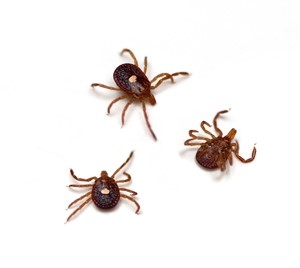
As the days cool down, it’s easy to assume ticks have called it quits. They haven’t. Ticks stay active well into fall, especially in leaf piles, tall grass, along fence lines, in brushy areas, and around woodpiles.
Ticks are arachnids, related to spiders. Unlike spiders, which help by eating flies and mosquitoes, ticks are external parasites that feed on blood. That feeding can make them more than a nuisance. Some ticks can pass along illnesses to people and pets.
Why Ticks Stick Around in Fall
Cooler temperatures don’t bother most ticks. What they want is moisture and shade. Fallen leaves, dense shrubs, uncut grass, cluttered woodpiles, and damp lawns create the perfect shelter. Wildlife like mice, squirrels, and deer often carry ticks right into backyards, and pets can bring them inside.
The Health Risks
Ticks can carry germs that cause illness. Lyme disease is the best known. It can start with fever, fatigue, headaches, and sometimes a circular rash near the bite. Without treatment, it can affect joints, the nervous system, and the heart. Other tickborne illnesses can also cause serious symptoms. If you notice unusual symptoms after a bite, talk to a healthcare provider.
How to Protect Yourself
Dress for it.
Wear long pants and long sleeves when you hike, rake leaves, or do yard work. Tuck pants into socks. Light-colored clothing makes ticks easier to spot.
Use repellents.
Apply an approved insect repellent with DEET, on exposed skin and clothing.
Do a tick check.
Shower after being outside and check your whole body, especially behind knees, under arms, around the waist, and along the hairline. Check pets and gear too.
Tidy the yard.
Keep grass short. Remove brush and leaf piles. Store firewood neatly and away from the house. Improve drainage so the lawn doesn’t stay damp.
If You Find a Tick
Use fine-tipped tweezers. Grab the tick close to the skin and pull straight out with steady pressure. Clean the area. Save the tick in a sealed bag or small container in case symptoms show up later. If you develop a fever, rash, or feel unwell after a bite, contact a healthcare provider.
Professional pest control can also help reduce tick activity around your home, especially if you live near woods or fields.